| Pages:
1
2
3 |
Grantr
Hazard to Self
 
Posts: 57
Registered: 19-9-2015
Member Is Offline
Mood: No Mood
|
|
I had some success with getting the spark gap to work. I do not have any ETN to try it. I hope to make some tomorrow.
I am using these Capacitors, two of these HV diodes and this HV power supply to make my unit. I have 4 of the caps in series for a total of 1.25UF and a rated voltage of 5200 volts. The little power supply
packs a punch. It sounds like a stun gun and will easily make about 1/2 inch arcs.
I am powering it with 2 AA batteries 3.0 volts. The largest arc I have tried was with a 6.5 mm center to center gap with the solid copper wire leads.
I have no idea what the voltage is. It will blow a piece of paper open that is wrapped around the gap. This is fired through 16 feet of 16 gauge
speaker wire.
I tired the r 6 cable and kept getting arc over on the end closed to the caps. I could not find where it was arcing over. I did leave the connectors
on the cable and solder my speaker wires to it. I am thinking the ends need to be removed and the shield wire stripped back some to make this work.
I am using 4mm coroplast sign board to make my detonators. I attached a few pictures. The unit is not complete as i need a battery holder and a
switch. I am using balsa wood for the box.
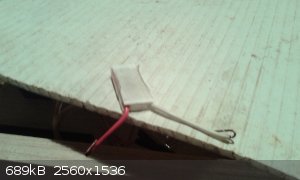 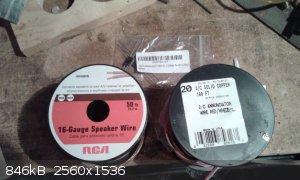 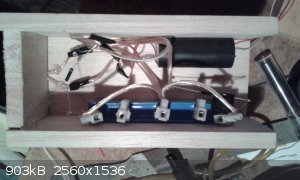
|
|
|
Hennig Brand
International Hazard
    
Posts: 1284
Registered: 7-6-2009
Member Is Offline
Mood: No Mood
|
|
Aurium, nice write-up about an interesting concept. I haven't done the actual tests but the distributed parameter model I used in the EBW thread would
indicate that 0.1uF could work for an EBW system as well.
Some interesting experiments here!
"A risk-free world is a very dull world, one from which we are apt to learn little of consequence." -Geerat Vermeij
|
|
|
Aurium
Harmless

Posts: 46
Registered: 4-10-2015
Member Is Offline
Mood: Energetic
|
|
Thanks Hennig.
To be honest, what led me to develop this idea was because I just couldn't get the damn thin wire to vaporize in the first place  . Oh well history repeats itself. . Oh well history repeats itself.
I do believe 0.1uF could make an EBW work, dependent on the wire distance ofc.
I'd love to try this SGD with smaller capacitors, say 0.025uF, very very near the detonator itself, a sacrificial capacitor. Sadly I'm currently away
from my lab.
Oh and thanks for finding me that article on http://nuclear-knowledge.com/detonators.php. Some interesting insights for sure. I had no idea the RPG-7 used a piezoelectric igniter.
Maybe Grant here can continue my experiments!
I'm not sure about your idea using that coroplast sign board for the detonator's body. Why not use a thin tube like I did?
And how are you using the diodes? The output from the HV module is already DC.
Anyway the box looks great! Sure beats my tupperware! Can't wait to see the finished project!
|
|
|
Grantr
Hazard to Self
 
Posts: 57
Registered: 19-9-2015
Member Is Offline
Mood: No Mood
|
|
I am using the diodes to keep the caps from trying to discharge into the HV supply. I guess I really do not need them since it is only on until it
fires the gap.
I did get the ETN made. I just need it to dry out and then recrystallize. Its still like wet tothpaste now. I wish i could find a quick way to dry it.
|
|
|
Grantr
Hazard to Self
 
Posts: 57
Registered: 19-9-2015
Member Is Offline
Mood: No Mood
|
|
I tested the spark gap and it failed to set off the ETN with 16 feet of speaker wire. I tried it 3 times. The 3rd time fried my caps as I cant get any
arc now and the caps do not hold energy after the charger is turned off. The ETN did blow away from the leads so i did get an arc in the ETN.
One cap does not read hardly any capacitance however the other 3 read the rated capacitance but they don't seem to work. I tried each one
indivudially and only one half way worked. The HV power supply still makes a nice arc when wired directly to the spark gap.
I hammer tested the ETN and then did the foil test with a cotton ball on fire a small pinch lightly packed in a aluminum foil tube the diameter of a
17hmr case and about 1/4" long made a loud sharp report the flatten the cotton ball.
I am going to order more caps and try the bride wire and an adjustable spark gap to fire it.
|
|
|
Aurium
Harmless

Posts: 46
Registered: 4-10-2015
Member Is Offline
Mood: Energetic
|
|
A simple way to test the caps is to measure innternal resistance. If its very low its busted. Put a spark gap in parallel and adjust it to the max
voltage of your caps. I broke a MOC because of this.
As far as I can see wrong with your experiments was that maybe the ETN was not recrystalized in methanol, pressed in too tight or the firing gap was
too long.
It was an iterative process making it work for me, but my design works flawlessly now and its pretty forgiving of randomness.
If you could share the way your detonators turned out perhaps I can see the problem and help you with it. 
|
|
|
Grantr
Hazard to Self
 
Posts: 57
Registered: 19-9-2015
Member Is Offline
Mood: No Mood
|
|
Aurium,
Cap are busted. No resistance measurement on them!
I did recrystallized in denatured Alcohol which is about 50/50 mix of ethanol and methanol. The electrodes were set in the 4mm tube and the ETN was
pushed down with a wood skewer lightly until I could not see the tip of the electrodes.
|
|
|
Aurium
Harmless

Posts: 46
Registered: 4-10-2015
Member Is Offline
Mood: Energetic
|
|
That is odd,
Well, my best guess is the arc was not happening through the ETN and maybe just under it since you are sure you drowned the electrodes in it.
I made a couple of attempts having the arc just above the ETN, just say 0.5mm, and it just shot out the ETN. When I made sure the spark did go through
it I had full reliability.
So is it possible the arc was forming under the ETN? Maybe some air gap between the ETN powder and the back of the detonator?
I'm sure you got it but maybe you'r overlooking some fine detail.
Apart from that: I never tried ethanol mixed with methanol, maybe that does invalidate my design.
My "recrystallization" I simply dissolved the ETN in hot MeOH, then cooled it, then added allot of water to the beaker until the ETN precipitated
down.
So I'm abusing the notion of recrystallization here. It's possible that the way I treated the ETN gave me a lower density than what you did, and that
that is critical to the design.
I feel tempted to criticize your capacitors. I imagine they'r not the problem, but I used axial motor rated PP film capacitors. These are the kind of
caps hobbyists use to build induction heaters, so maybe there is a practical difference between these and yours.
Argh.. really wish I had access to my lab right now, to experiment and see if I missed some fine important detail.
|
|
|
Grantr
Hazard to Self
 
Posts: 57
Registered: 19-9-2015
Member Is Offline
Mood: No Mood
|
|
Well I failed to get this to work again and fried the caps again trying to get more power. It did work only one time with the spark gap. I taped the
gap to a piece of plastic sign board and poured some ETN on the gap and taped the ETN over the electrodes. That popped. I wrapped paper around the
electrodes and filled with ETN. Paper exploded dumping the ETN. I tried 40 gauge bridge wires with the same results.
I tried it with ETN in a 3/4" Diameter pvc pipe with the spark gap in the middle of a pile of ETN. All I got was white fumes and some ETN sparying
out.
I have no idea where to go from here. I am thing of feeding the microwave oven xformer output directily into a pile of ETN. I think that will set it
off however that is overkill and will not work well for me.
I did set a series spark gap so I could fire the caps when i wanted to. I used a screw driver to slide in the gap to cause it to arc over.
|
|
|
Grantr
Hazard to Self
 
Posts: 57
Registered: 19-9-2015
Member Is Offline
Mood: No Mood
|
|
I tried a spark gap powered directly from the MOT stuck down in a lose pile of ETN. The output tripped my 15 amp breaker after about 5 seconds. I
tired it again two more times. One very slight pop was all that happened. I inspected the tube later to find the arc had melted a large amount of the
ETN. Some of it was still powdered.
I also tried stainless Aviation safety wire stuck down in some lose ETN. It just caught on fire and burned. The wire would glow white hot with 12
volts.
ETN apparently has to have just the right energy input to get it to detonate. I did have a small pile rolled in foil and set on fire make a loud bang
and knock a board it was sitting by back about 20 feet. Setting it on fire is very hit and miss.
|
|
|
Aurium
Harmless

Posts: 46
Registered: 4-10-2015
Member Is Offline
Mood: Energetic
|
|
MOTs are awesome right!
Still I don't think you'll have much luck using one to trigger the ETN.
I just can't yet guess why you hadn't any success with the setup I detail here. By your description everything's right.
The one thing I'm not sure about is the density of your ETN.
Try recrystallizing like I said in my previous post, maybe that'll lower it's density and give you better results with the spark gap method.
Also, how does your ETN "look" when compared to my pile I show in the header post?
Good luck  . .
|
|
|
Grantr
Hazard to Self
 
Posts: 57
Registered: 19-9-2015
Member Is Offline
Mood: No Mood
|
|
Yea MOT is crazy! I am going to use it with the voltage doubler to get 4200 volts so I hopefully do not burn up my new caps. Do you know if a MOT's
high output current will damage the caps? Four 5uf 1300 volt caps in series will have the voltage capabilities.
I think my ETN looks about the same. Feels light and fluffy.
[Edited on 2-11-2015 by Grantr]
|
|
|
Grantr
Hazard to Self
 
Posts: 57
Registered: 19-9-2015
Member Is Offline
Mood: No Mood
|
|
I had one successfully attempt with a MOC cap at 2100 volts and a spark gap in the ETN. A small 4mm tube of about .3 grams ETN made a loud report like
a pistol with the tube blown to pieces. Since then no success other than slight pops that rupture the tube or blow then ends out.
I am going to try these capacitors since I do not think high capacitance is needed. I assume these can discharge faster than the 5uf caps I tried before. I will run two in series at 2kv or 3 in series at 4kv.
Attached is a pic of my recrystallized ETN. I think it is low density.
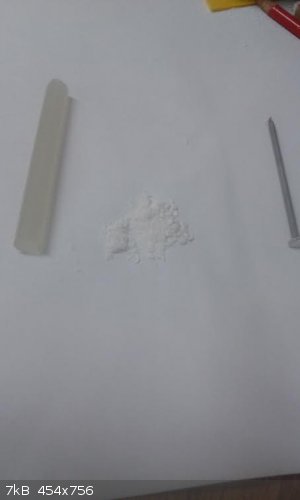
|
|
|
Aurium
Harmless

Posts: 46
Registered: 4-10-2015
Member Is Offline
Mood: Energetic
|
|
Good to hear you finally had some success!
If I were you I'd try to make it work every time with the MOC first, and only then try using lower capacitors. Too big of a cap is not a problem, nor
too short of a cable.
Those eBay caps say they're 6200pF. Thats 6.2 nF isn't that a bit low?
From the photo you took your ETN looks still a bit higher density than mine, maybe its the insufficient light in the photo but mine looks more flaky
than yours.
2100 V is low. I know you busted your caps due to overvoltage but with the MOC you can go up to 10kV. Remove it's bleeder resistor and use the HV
module to charge it. To avoid overvoltage build a variable spark gap in parallel with the capacitor.
Start with a short gap and then tune it up and up until the capacitor is able to reach enough voltage for the SGD.
Good luck!
|
|
|
Grantr
Hazard to Self
 
Posts: 57
Registered: 19-9-2015
Member Is Offline
Mood: No Mood
|
|
How did you recrystallize to get low density? Did you heat the alcohol to 50C or so and crash the hot solution in ice water?
|
|
|
Aurium
Harmless

Posts: 46
Registered: 4-10-2015
Member Is Offline
Mood: Energetic
|
|
Yep.
Heat the methanol first before adding the ETN. Then just throw it in excess cold water.
See if this makes the trick.
|
|
|
Grantr
Hazard to Self
 
Posts: 57
Registered: 19-9-2015
Member Is Offline
Mood: No Mood
|
|
Ok I did not do it that way. I let the hot mix cool some and then dumped into excess cool near room temp water. I used 350ml alcohol to the 30 grams
of ETN I obtained.
I have 2 MOTs and 2 MOCs. I will connect the MOC in series and feed 4kv to them for a better test.
|
|
|
Grantr
Hazard to Self
 
Posts: 57
Registered: 19-9-2015
Member Is Offline
Mood: No Mood
|
|
Success!
Hot damn you were right my ETN was too dense! I heated the denatured alcohol to 60c and added the ETN while stirring until all dissolved. I then
crashed in a beaker of crushed ice water while stirring.
The product drys into thin light weight snow like sheets of ETN . When crushed up the crystals are super small.
I used one MOT feeding into the voltage doubler from the microwave to get 4kv. The 4kv charged another .8 uf MOC with the internal resistor removed. A
spark gap triggered by a screw driver fires the circuit. Two solid wire leds are pushed into 2mm coroplast to secure them and provide a gap of about
2mm. This is pushed lightly into the top of the lose ETN in the straw and taped in place.
The test caps was made form a large drinking straw from McDonalds. I cut 4 of them to different lengths not exceeding 1 inch. 4 test gave me 4
detonations. Very sharp boom. I used an 1/16" think .75 X .75 inch aluminum C channel as a witness plate. The plate was punched through by the cap.
This cap had about 1/4 inch of hand pressed ETN in the bottom sitting on the plate. A piece of straw fits the dent perfectly.
I did not weigh the charges.
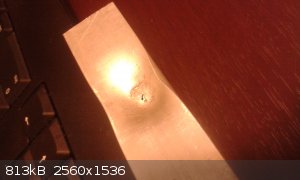
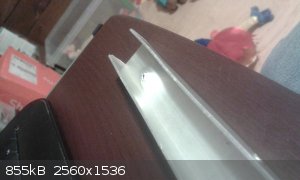
|
|
|
Bert
Super Administrator
        
Posts: 2821
Registered: 12-3-2004
Member Is Offline
Mood: " I think we are all going to die. I think that love is an illusion. We are flawed, my darling".
|
|
One technique for producing very fine crystals of explosive materials for use in det cords, plastique, caps or such is to pump the hot solution
through a spray nozzle adjusted to make very fine droplets, into a relatively large volume of rapidly stirred ice water. There are patents on using
this method to make RDX crystals fine enough to serve in rather low loading det cords. Smaller crystals/lower density seem to be what you're after
here...
It is useful to include a scale of some type next to affected areas in pictures of damage done to witness plates- And weighing & recording
quantities of materials used should be standard procedure.
Rapopart’s Rules for critical commentary:
1. Attempt to re-express your target’s position so clearly, vividly and fairly that your target says: “Thanks, I wish I’d thought of putting it
that way.”
2. List any points of agreement (especially if they are not matters of general or widespread agreement).
3. Mention anything you have learned from your target.
4. Only then are you permitted to say so much as a word of rebuttal or criticism.
Anatol Rapoport was a Russian-born American mathematical psychologist (1911-2007).
|
|
|
Aurium
Harmless

Posts: 46
Registered: 4-10-2015
Member Is Offline
Mood: Energetic
|
|
I'm happy to know that you'v had success there Grant!
It was my bad though, I never tried processing the ETN any other way but the one I described above, and so I did know how important this was.
- Anyway now we know that very low density ETN is required.
- Dissolving the ETN in hot alcohol (or acetone maybe) and then crashing it into ice water is the best way to achieve this.
I see you made your setup to be triggered mechanically.
I never tried including a trigger device, but millisecond triggering would be interesting for experiments with unique shaped charges and for Fuel-air
explosives.
I can imagine a simple three electrode trigatron made with a HV supply like the HV module I showed or some other ignition coil type device for
millisecond control as with any EBW setup.
Keep testing those SGDs!
I'll be glad to hear if you find something new about them.
Bert
That's quite a special method that I had never heard about!
I'll have to try it next time I make ETN.
I can only think of a bottle of window cleaner as a simple way to spray the mixture into fine droplets. The processing rate would be painfully slow
though.
|
|
|
Grantr
Hazard to Self
 
Posts: 57
Registered: 19-9-2015
Member Is Offline
Mood: No Mood
|
|
Bert,
The next set of test I will give more data. I wanted to run a few more test 1st before weighing charges and so on. Interesting to spray a fine mist
into the cold water to make a finer product. Without some sort of pressurization that would be a slow process and the solution would likely cool
before it was completely added to the cold water.
Aurium,
No problem. It is a learning process. The low density is critical to this working. Thanks for sharing your SGD design. It is very easy to setup.
Mechanical triggering works every time. The MOT only charges the cap to 4kv so I leave it on for 5 seconds or so and poke the screwdriver into the gap
and boom! Now that I have it working I am going to make the unit mobile so I can abandon the MOTs.
|
|
|
Laboratory of Liptakov
International Hazard
    
Posts: 1333
Registered: 2-9-2014
Location: Technion Haifa
Member Is Offline
Mood: cool.gif
|
|
I do not advocate the use of high voltage on ETN. But I see a nice piece of work. Congratulations to repeated detonation. Dr. Lipatkov
|
|
|
Grantr
Hazard to Self
 
Posts: 57
Registered: 19-9-2015
Member Is Offline
Mood: No Mood
|
|
The test I just performed was on 1/16" wall square mild steel tubing.
The detonator was made from a piece of clear vinyl tubing with an inside diameter of 1/4" and outside diameter of 3/8". A piece of scotch tape was
tapped over one end.
.59 grams of ETN was hand pressed into the tube against the taped end. The pressing was done with a 1/4" drill bit and a wood block with all of my
weight on it. 155 pounds. I do not know how to measure the density of the pressed.
.18 grams of low density ETN was added on top of the pressed ETN. This was not pressed at all. The 2mm coroplast lead holder was pushed into the top
of the tube and taped in place. Spark gap is 2 to 3mm and down in the loose ETN.
The detonator was taped to the top of the steel tubing with 2 pieces of scotch tape. The piece of metal blown out from the top slammed into the bottom
wall bulging it out.
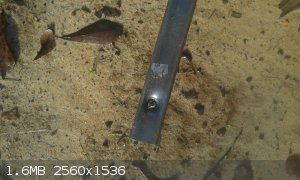 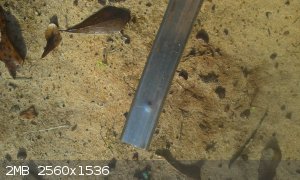 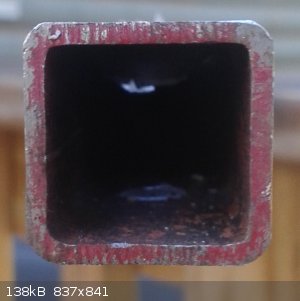
|
|
|
Bert
Super Administrator
        
Posts: 2821
Registered: 12-3-2004
Member Is Offline
Mood: " I think we are all going to die. I think that love is an illusion. We are flawed, my darling".
|
|
| Quote: |
Interesting to spray a fine mist into the cold water to make a finer product. Without some sort of pressurization that would be a slow process and the
solution would likely cool before it was completely added to the cold water.
|
From my couple of brief attempts at this, you will not get far with a hand sprayer- Saturated solutions will cool on the way out and clog the spray
orifice. Additionally, the evaporation in air of the solvent further chills the nozzle! One of the articles I read on this technique (using PETN)
mentioned issues with clogged nozzles, need to pre-filter solutions, arrangements for nozzle/delivery line heating.
Useing an air pressurized vessel, the process done "all in one go", rather quickly through a pre heated spray orifice, enough hot solution passing
through the spray orifice quickly enough to keep it above crystalization temperature sort of worked. But if you pause, you will need to re-heat the
nozzle (NOT RECOMENDED!) or disassemble, clean and start over. It was a painful and frustrating learning experience, yielding very little final
product and lots of waste. I eventually gave up and did something else.
I never tried using a more dilute solution, which might solve some of the clogging issues, although likely requiring an even larger volume of cold
water to accept the spray mist.
In any case, it seems crashing a saturated solution into ice water is doing what you want...
I am still interested in arc discharge into secondaries as a method of performing very small video studio/green room or model shots- Although bringing
high voltage equipment into the studio to replace small quantities of primaries is certainly just changing the nature of the danger, rather than
eliminating it.
The ready made movie industry HE squibs/bullet hits and such available to me are rather expensive, and most such products available in USA are based
on Lead compounds. Not something I like in an indoor work area, in Europe they do offer non Lead based versions.
http://www.pyrochemie.at/e_bleifrei.htm
http://www.pyrochemie.at/e_patent.htm
[Edited on 12-11-2015 by Bert]
Rapopart’s Rules for critical commentary:
1. Attempt to re-express your target’s position so clearly, vividly and fairly that your target says: “Thanks, I wish I’d thought of putting it
that way.”
2. List any points of agreement (especially if they are not matters of general or widespread agreement).
3. Mention anything you have learned from your target.
4. Only then are you permitted to say so much as a word of rebuttal or criticism.
Anatol Rapoport was a Russian-born American mathematical psychologist (1911-2007).
|
|
|
Grantr
Hazard to Self
 
Posts: 57
Registered: 19-9-2015
Member Is Offline
Mood: No Mood
|
|
Bert,
The SGD works every time with the low density ETN. I like this method of firing since I have no interest in making complicated toxic primarys or
dangerous peroxides. I am going to rebuild my HV supply so it is small and portable.
4kv in an .8 uf cap is definitively dangerous. The arc pop is loud enough to hurt my ears. I feel it is a safer method of firing since ETN is not
sensitive like primarys are.
Liptakov,
Why do you dislike high voltage? Nice work on your NPED detonators. I watched your videos and was about to make one until I solved the SGD issue.
|
|
|
| Pages:
1
2
3 |